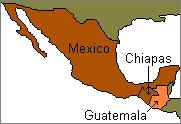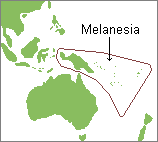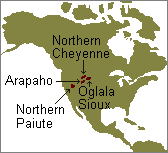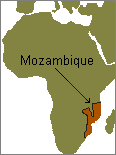When alien culture traits diffuse into a society on a massive scale, acculturation frequently is the result. The culture
of the receiving society is significantly changed. However, acculturation does not
necessarily result in new, alien culture traits completely replacing old indigenous
![]() ones. There often is a syncretism
ones. There often is a syncretism
![]() ,
or an amalgamation of traditional and introduced traits. The new traits may be
blended with or worked into the indigenous cultural patterns
to make them more
acceptable.
,
or an amalgamation of traditional and introduced traits. The new traits may be
blended with or worked into the indigenous cultural patterns
to make them more
acceptable.
 |
|
The
Highland Maya
![]() Indians of Guatemala and Chiapas
Indians of Guatemala and Chiapas
![]() State of Southern Mexico provide an example of
religious syncretism. Spanish colonial authorities forced Christianity upon them
beginning in the 16th century. However, the Maya defined some of the Christian
saints as also being their ancient Indian gods. As a result, their indigenous
religious belief system was essentially only added to and modified. The overt religious
practices seemed to be Christian to the Spanish authorities but they retained dual
meanings for the Maya. Their religion was enriched by the syncretism.
State of Southern Mexico provide an example of
religious syncretism. Spanish colonial authorities forced Christianity upon them
beginning in the 16th century. However, the Maya defined some of the Christian
saints as also being their ancient Indian gods. As a result, their indigenous
religious belief system was essentially only added to and modified. The overt religious
practices seemed to be Christian to the Spanish authorities but they retained dual
meanings for the Maya. Their religion was enriched by the syncretism.
 |
|
British
culture-dominated |
Whether acculturation takes place often depends on the
relationship between the culture that is receiving the new traits and the culture of their
origin. If one society is militarily dominant in the culture contact and they
perceive their own culture as being superior in terms of technology and quality of life,
it is not likely that they will be acculturated. This was the case in the contact
between the British settlers of Australia and the Aborigines
![]() they encountered. Visiting an Australian
city today, you see European culture almost exclusively. The English generally did
not adopt Aborigine ways. However, some minor traits, such as words for plants,
animals, and geographic locations, were accepted by the
British. Since they were in
control of the contact situation, the British were able to pick and choose the traits that
would be incorporated into their culture.
they encountered. Visiting an Australian
city today, you see European culture almost exclusively. The English generally did
not adopt Aborigine ways. However, some minor traits, such as words for plants,
animals, and geographic locations, were accepted by the
British. Since they were in
control of the contact situation, the British were able to pick and choose the traits that
would be incorporated into their culture.
 |
|
Ancient Roman city |
|
If a society is militarily
dominated but still perceives its culture to be superior, it also is not likely to be
acculturated to the dominant society's culture. This sort of disdaining rejection of
acculturation occurred following the collapse of the Western Roman Empire during the 5th
century A.D. The end finally came as a result of repeated invasions by militarily
superior Germanic tribes. The Romans did not adopt the language or other cultural
patterns of their conquerors. It was just the opposite.
The Goths
![]() and other Germanic
tribes generally adopted Roman Christianity, the outward trappings of the Roman political
system, and Latin as the language of learning.
and other Germanic
tribes generally adopted Roman Christianity, the outward trappings of the Roman political
system, and Latin as the language of learning.
A society that is militarily
dominant in a culture contact situation but perceives its culture as being inferior is a
likely candidate for acculturation. This was the case with the
Mongols
![]() of North
Central Asia under Genghis Khan
of North
Central Asia under Genghis Khan
![]() after they conquered China in the 13th century A.D.
The Mongolian occupiers largely adopted Chinese culture within a generation. They
were acculturated by the people who they had defeated in war.
after they conquered China in the 13th century A.D.
The Mongolian occupiers largely adopted Chinese culture within a generation. They
were acculturated by the people who they had defeated in war.
 |
|
| Frenchman | |
 |
|
| Englishman | |
Contact between societies that are militarily and technologically equals rarely results in acculturation. This is especially true if both societies believe themselves to be culturally superior to the other. Contemporary France and England are an example. Words, foods, and other relatively superficial cultural traits regularly diffuse back and forth between them (especially in the upper social classes), but there is no massive influx of cultural traits. As a result, the Frenchman (on the left) remains strongly French and the Englishman (on the right) remains proudly English in culture.

|
|
Australian Aborigine |
In contrast, rapid, psychologically overwhelming acculturation usually occurs in societies that are both militarily dominated and believe themselves to be culturally inferior in terms of technology and quality of life. Many of the indigenous societies of Australia and North America suffered this fate. Not only were they ultimately powerless to prevent the occupation of their lands but they could not effectively control the impact of the alien culture on their own people. The consequence frequently was massive acculturation and the replacement of indigenous cultures with little syncretism with their own traditional cultural patterns. The fact that the Australian Aborigine shown here is wearing European clothes is an indication that his traditional culture is not intact.
Millenarian
Movements
When a society is helpless
to resist a massive cultural invasion and strong pressure to abandon traditional cultural
patterns in favor of alien ones, there is usually considerable psychological stress.
There is nearly constant culture shock in
response to the new reality and disorientation from the failure of traditional skills and
values in dealing with the rapidly changing situation. Under these circumstances, it
is common for millenarian movements
![]() to occur. These are conscious, organized
attempts to revive or perpetuate selected aspects of the indigenous culture or to gain
control of the direction and rate of culture change. These movements have also been
referred to as messianic
to occur. These are conscious, organized
attempts to revive or perpetuate selected aspects of the indigenous culture or to gain
control of the direction and rate of culture change. These movements have also been
referred to as messianic
![]() , nativistic
, nativistic
![]() , and revitalization
, and revitalization
![]() movements.
movements.
 |
Millenarian movements are started and led by prophets
who preach a religious-like belief in the coming of a new
millennium
![]() , or period of great happiness, peace, and
prosperity brought about by a new order of things. Some of the best known millenarian movements were the
Cargo Cults
of New Guinea and neighboring islands of Melanesia
, or period of great happiness, peace, and
prosperity brought about by a new order of things. Some of the best known millenarian movements were the
Cargo Cults
of New Guinea and neighboring islands of Melanesia
![]() . They first appeared in 1931 at
Buka
. They first appeared in 1931 at
Buka
![]() in the Solomon Islands. Prophets
in the Solomon Islands. Prophets
![]() predicted
that a flood would soon engulf all Europeans in the region. This flood would be
followed by the arrival of ships laden with European goods. Cult
predicted
that a flood would soon engulf all Europeans in the region. This flood would be
followed by the arrival of ships laden with European goods. Cult
![]() believers were to construct storehouses for the goods
and to prepare to repulse colonial police. Because it was predicted that the cargo
ships would arrive only after the believers used up their own supplies, they stopped
farming.
believers were to construct storehouses for the goods
and to prepare to repulse colonial police. Because it was predicted that the cargo
ships would arrive only after the believers used up their own supplies, they stopped
farming.
|
|
|
Women in Papua New Guinea |
|
The 1931 Cargo Cult leaders were arrested and the cult quickly died. However, it cropped up again and again in various forms throughout Melanesia, especially after World War II. Some of the later movements blended Christian theology with indigenous cultural ideas. For instance, the resurrection of dead Melanesians was to coincide with the destruction and enslavement of Europeans. Later Cargo Cults also tended to focus more on controlling the ongoing acculturation rather than stopping it. Believers were promised that they would soon get European material wealth and knowledge without being dominated by their colonial masters.
A North American Indian
equivalent of the Cargo Cult was the Ghost Dance Movement of the late 19th
century. It began in Northwestern Nevada with a prophet named Tvibo
![]() . He was
a partially acculturated Paviotso
. He was
a partially acculturated Paviotso
![]() (Northern Paiute
(Northern Paiute
![]() ) Indian who had worked enough as a
ranch hand to get a superficial understanding of European American culture. In
1869, he began preaching his ideas about a new order of things that was coming.
As a result of visions, he claimed that all non-Indian Americans would be destroyed by a
catastrophic earthquake and that the Indians would get all of their wealth and
power. Dead Indians would return to the living, food would be plentiful, and all
would live peacefully and happily together. These millenarian ideas spread over the
Sierra Nevada Mountains to North and Central California in 1870 where they
flourished. The Ghost Dance followers were instructed to purify themselves, dance in
a certain way, and sing special songs in order to hasten these changes. By 1872,
most of the followers lost faith and the movement began to die out. This was
followed by even more rapid acculturation in North and Central California.
) Indian who had worked enough as a
ranch hand to get a superficial understanding of European American culture. In
1869, he began preaching his ideas about a new order of things that was coming.
As a result of visions, he claimed that all non-Indian Americans would be destroyed by a
catastrophic earthquake and that the Indians would get all of their wealth and
power. Dead Indians would return to the living, food would be plentiful, and all
would live peacefully and happily together. These millenarian ideas spread over the
Sierra Nevada Mountains to North and Central California in 1870 where they
flourished. The Ghost Dance followers were instructed to purify themselves, dance in
a certain way, and sing special songs in order to hasten these changes. By 1872,
most of the followers lost faith and the movement began to die out. This was
followed by even more rapid acculturation in North and Central California.
 |
|
Oglala Sioux dancing the Ghost Dance |
|
|
|
|
|
|
Wovoka
(Jack Wilson) |
|
 |
|
A second Ghost Dance Movement began a
generation later as a result of prophesies by Wovoka
![]() (also known as Jack Wilson). Wovoka may have been a young relative
of Tvibo. It was claimed that Wovoka died of a fever and returned to the living
after being told by God to renew the Ghost Dance Movement. Beginning in 1889, his
preaching excited the Northern Plains Indians. He
said that a new messiah was coming and that he would bring the ghosts of the
Indian dead to join the living. In preparation, men and women had to
purify themselves and give up alcohol and violence. They also had to
dance in a large circle appealing to their ancestors for help. If this
was done properly, the old Indian ways would be restored and the Plains
Indians would be independent and powerful once again. This movement was taken on with great
religious fervor in 1890 by the Arapaho
(also known as Jack Wilson). Wovoka may have been a young relative
of Tvibo. It was claimed that Wovoka died of a fever and returned to the living
after being told by God to renew the Ghost Dance Movement. Beginning in 1889, his
preaching excited the Northern Plains Indians. He
said that a new messiah was coming and that he would bring the ghosts of the
Indian dead to join the living. In preparation, men and women had to
purify themselves and give up alcohol and violence. They also had to
dance in a large circle appealing to their ancestors for help. If this
was done properly, the old Indian ways would be restored and the Plains
Indians would be independent and powerful once again. This movement was taken on with great
religious fervor in 1890 by the Arapaho
![]() , Northern
Cheyenne
, Northern
Cheyenne
![]() , and
Oglala
Sioux
, and
Oglala
Sioux
![]() .
All
of these peoples were then embittered by being forced to settle on reservations where
there was inadequate food supplies. Emboldened by "ghost shirts" with
painted symbols that supposedly would protect them from bullets, many left their
reservations and renewed hostility with the U.S. Army. This proved to be a tragic
decision. They were hunted down and many were killed at Wounded Knee and other
skirmishes. The Ghost Dance Movement failed to deliver its promises and was
abandoned.
.
All
of these peoples were then embittered by being forced to settle on reservations where
there was inadequate food supplies. Emboldened by "ghost shirts" with
painted symbols that supposedly would protect them from bullets, many left their
reservations and renewed hostility with the U.S. Army. This proved to be a tragic
decision. They were hunted down and many were killed at Wounded Knee and other
skirmishes. The Ghost Dance Movement failed to deliver its promises and was
abandoned.
All of these and other millenarian movements around the world have a number of things in common. They typically develop in small, previously isolated societies with low levels of technology. They are largely a response to the psychological stresses resulting from oppressive culture contact situations in which they are pressured to acculturate with little control over the changes. Their old cultural ways no longer seem to work and the new, alien culture is only partly understood. They also usually use supernatural means to carry out their goal. This involves a leap of faith. In doing this, they are acting rationally from their own culture's perspective. However, they are using good logic based on false assumptions.
The goal of millenarian movements is usually one of two things--the elimination or control of the alien people, customs, and values that are threatening the native ones. These movements are deliberate, organized, conscious efforts to construct or reconstruct a satisfying culture. While there is a focus on particular aspects of culture, apparently there is always a perception of the culture as a whole system in the minds of a movement's participants.
Millenarian movements are,
in a sense, healthy signs in that they occur only as long as there is enough of the old
culture surviving to be viable. These movements are attempts to stem the tide of
psychological disorientation by constructing a meaningful culture from what is remembered
of the past and what is poorly understood of the alien culture that is dominating
them. If acculturation has proceeded to the point that there is little of the old
culture left and there is widespread anomie
![]() , a
millenarian movement is much less likely to occur.
, a
millenarian movement is much less likely to occur.
 |
|
Millenarian movements are not just a phenomena
of the past. They still appear from time to time. A recent one called
Naparama
![]() (literally "irresistible force") developed in Mozambique during the 1980's. This movement was spawned in the chaos
and destruction of a prolonged civil war. Mass starvation and cultural
disintegration were rampant. Manuel Antonio was the prophet leader of the
Naparama
"Spirit Army." He was a mysterious man in his 20's who intentionally kept
his tribal identity a secret. He attracted followers by saying that he had died of
measles and after 6 days had risen from the grave to receive a message from God
instructing him to liberate people behind the lines of the Renamo
(literally "irresistible force") developed in Mozambique during the 1980's. This movement was spawned in the chaos
and destruction of a prolonged civil war. Mass starvation and cultural
disintegration were rampant. Manuel Antonio was the prophet leader of the
Naparama
"Spirit Army." He was a mysterious man in his 20's who intentionally kept
his tribal identity a secret. He attracted followers by saying that he had died of
measles and after 6 days had risen from the grave to receive a message from God
instructing him to liberate people behind the lines of the Renamo
![]() Army faction that opposed the central government forces.
Army faction that opposed the central government forces.
A core Naparama belief was that warriors who were "vaccinated" would be protected from bullets, spears, and knives. "Vaccination" was a rite in which numerous cuts were made on the chest and neck of initiates with a razor blade. Ashes and unidentified herbs were rubbed into the wounds. At the conclusion, initiates were struck hard with the sharp edge of a panga to prove their invulnerability. If the initiate flinched, the "vaccination" procedure was considered to be a failure and was repeated. Twenty or more teenage boys were usually initiated at a time. When at its peak, the Naparama movement reportedly had about 3,000 dedicated followers.
When the Naparama warriors went into battle, each carried a short spear and a red ribbon pinned on their clothing for protection from bullets. Antonio said that this provided magical protection that would work as long as the young men did not give in to fear. During the late 1980's, the Naparama Spirit Army apparently overran at least 24 well armed Renamo rebel strongholds. Reportedly, the Renamo defenders gave up without a fight when confronted by the magic of Naparama. With the end of the Mozambique civil war in the early 1990's, the Naparama Spirit Army seems to have faded away.
Many charismatic leaders have founded millenarian movements in rapidly changing modern industrialized nations as well. While they did not arise in small isolated, technologically limited societies, as was the case with the Cargo Cults and Ghost Dance Movements, they share many of the same characteristics. The followers typically are disillusioned, alienated people who are desperately searching for a more meaningful world view. Recent, examples of these new movements in America include the People's Temple in the 1970's (led by Reverend Jim Jones), the Branch Davidians in the late 1980's and early 1990's (led by David Koresh), and Heaven's Gate in the late 1980's and 1990's (led by Marshall "Do" Applewhite). All three movements failed to achieve their prophesized rewards and came to an abrupt end with murder and mass suicide.
There have been other
similar religion focused millenarian movements that have not failed. Examples of
these include the Jehovah's Witnesses (founded by Charles Russell in the 1870's),
and the Church of Jesus Christ of Latter Day Saints (founded by Joseph Smith in the
1830's). Likewise, some indigenous millenarian movements elsewhere in the world have
survived by changing and adopting methods that do not require magic and leaps of
faith. For example, the Mau-Mau
![]() Movement in Kenya during the early 1950's
survived, after a bitter but successful war of independence against
Britain, by evolving
into a national political movement.
Movement in Kenya during the early 1950's
survived, after a bitter but successful war of independence against
Britain, by evolving
into a national political movement.

